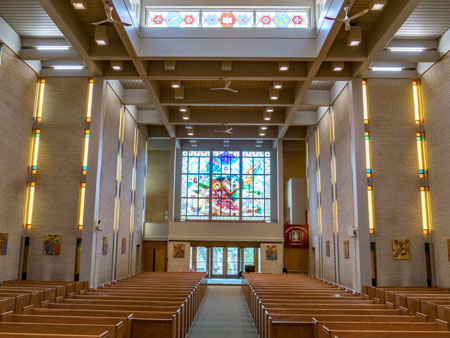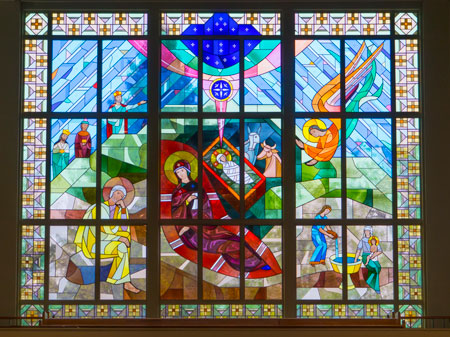The Sanctuary of St. Joseph’s
On Sunday, June 5th, 2011, St. Joseph’s Ukrainian Catholic Parish in Winnipeg warmly welcomed His Grace Metropolitan Lawrence who reverently blessed the new Church Decorations during 11:00 am Liturgy. The parish was more than pleased to host His Grace and the many parishioners at the following celebratory reception. Also a very special guest of honor was Father Joseph Denischuk CSsR, the founder of St. Joseph’s Parish in 1952. The pioneers warmly welcomed Fr. Joseph who proudly celebrated his 90th birthday on March 2nd, 2011.
The following is an article explaining the various Church Decorations (Phase I and II) that have taken place over the past year and an attempt to explain the richness of our Byzantine Ukrainian faith and tradition. Many of these thoughts could be easily applied to many of our Ukrainian parishes.
The Holy Altar:
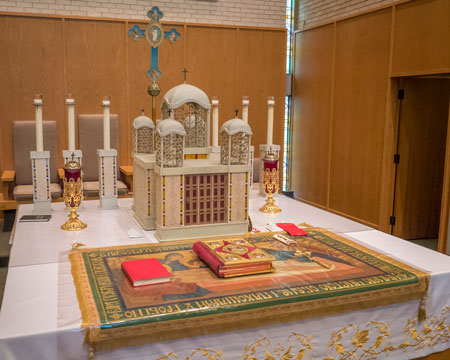
The altar is placed in the centre of the sanctuary and is the most sacred object in the church. It is called the Holy Table, because it represents the Last Supper table of the upper room where the Lord shared His Mystical meal with His disciples. It is seen as the Throne of God for on it rests the Holy Gospels – the “Word of God”. The altar is the sign of God’s glory and majesty. On the altar are kept: the Gospel Book as a sign of the Living Word dwelling in our midst, the cross as a sign of Jesus’ sacrifice, and the Eucharist, kept in the tabernacle, as a sign of our Eternal Covenant with God in Jesus Christ. Also kept on the altar is the antimension, a small decorated cloth which depicts the Lord Jesus being placed in the tomb. Sewn into the antimension is a relic of a Saint as a sign of a Catholic’s pledge to die for Christ and to live with Christ. It was presented to St. Joseph’s by Metropolitan Maxim as a sign of his jurisdiction over the celebration of the Eucharist in the parish.
The Icon of the Resurrection
The majestic icon mosaic on the sanctuary wall portrays the Risen Christ, who has descended into Hades, smashed the gates of hell, destroyed the power of Satan and freed Adam and Eve who represent all humanity. Jesus holds the three bar cross as a sign of liberation. The Resurrection of Jesus offers everyone the glorious gift of salvation. “Christ is risen from the dead, trampling death by death and to those in the tomb, granting life!”
The Icon Screen – the ICONOSTAS
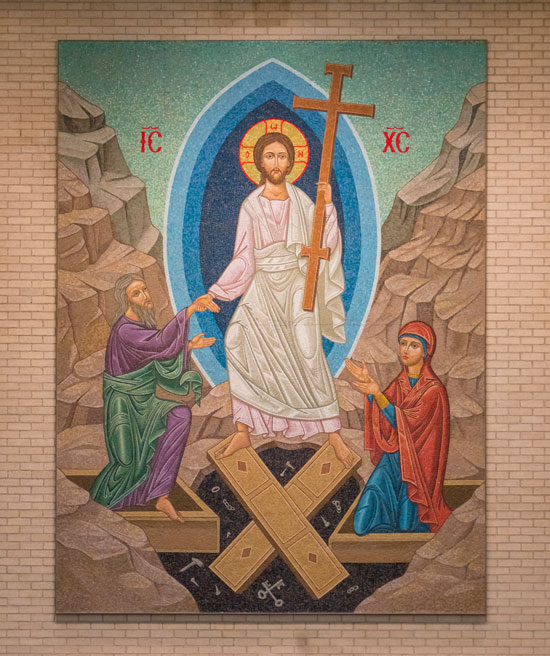
Icons are traditionally characteristic of all Byzantine churches. An “icon” is a stylized religious d
epiction of any sacred person or event. The word “icon” comes from the Greek “eikon” – which means “image” – “to see”. It is an attempt for all to visualize the sacred persons and events of the faith, “to see” in them the divine presence of God’s great love for all of us. Since God became man in Jesus Christ, we are now able to look upon His image. “What the word transmits through the ear, the painting shows silently through the icon, and by these two means mutually, accompanying one another, we receive knowledge of one and the same thing.” (St. Basil)
To demonstrate the transforming relationship which happens when one enters into union with God, a highly stylized “writing” technique is used. The face on the icon is elongated, the eyes are always large, almost penetrating. They look beyond us and invite us to enter into the divine world. The nose is also long and extended, a sign of the just man who is slow to anger (Jonah 4:2) All the senses are marked by a sign of God’s transformation.
The Iconostas.
The Iconostas serves as a visible sign of the union of Heaven and earth, of the “Holy of Holies”, of the union with God and humankind. The icons focus one’s attention on the sanctuary – the place where God resides – and helps one see and understand more readily the great mystery of God’s love.
In the center of the Icon screen are the Royal doors. The icons of the Evangelists – Matthew, Mark, Luke and John – are always included in these doors for they are the proclaimers of the Gospel – the “Good News”. Also portrayed isthe icon of the Annunciation – the Archangel Gabriel announcing to Mary that she will give birth to the Son of God. The cherubic angels, praising God, are etched in glass in the Royal doors, reminding worshippers of the angels, singing “Holy, Holy, Holy”
The Gospels proclaim that Christ’s life, death and resurrection are the great saving act of love. Through Jesus the kingdom of God is opened to everyone. The Royal Doors are thus symbols of the Gates of Paradise. They are opened as an invitation for us to share in this Kingdom. The priest therefore enters through these doors only when he acts in Christ’s name.
The Icon of Jesus Christ is always placed to the right of the Royal doors.
Jesus sits at the right hand of the Father and constantly intercedes for us. He is our high priest. The halo over Jesus asserts His divinity. With the halo is a cruciform shape, the sign of His victory over death. The Greek letters are “0 W N”, a translation of the Hebrew name “Yahweh” given by God to Moses which means “I AM WHO I AM”. On either side of the halo are the letters IC and XC – “Jesus Christ” The right hand of Jesus is raised in blessing and the left hand holds the Gospel Book – the Good News of salvation. The dark red of his garment represents His divinity and the deep blue acknowledges He is also human – the “Son of God”. The golden sash signifies His royalty as King of the universe. Laser-etched into the glass plate beneath the icon is the CHI RHO, the earliest symbol of Jesus Christ with the Greek letters Alpha and Omega – “the Beginning and the End”.
The Icon of the Mother of God with the Greek letters MP OV is always to the left of the Royal Doors. Every icon of the Virgin Mary includes her Son, Jesus Christ. She looks beyond those prayerfully gazing at her as she with her right hand points to her Son as the Way who has come into the world through her. The blue or green in her garment symbolizes her humanity and virginity, but by giving birth to the Son of God, she is clothed in red with divine life. The child Jesus gazes directly at all. He is Emmanuel, full of wisdom, despite His tender years. The Mother of God becomes for everyone a model of faith and acceptance of God’s Word. Like her, Christians are personally called to present Christ to the world. The etched symbols recognize her greatness in salvation – the monogram of Mary, the Crown – the Mother of God, the Morning Star who gave birth to the “Sun” of God and the White Rose – her Immaculate purity.
The Deacon doors display St Stephen the first Martyr on the right and Archangel Michael on the left. These doors are normally closed but are opened during liturgical processions.
The Icon of St. Joseph, the patron of this parish, is placed on the right side of the Iconostas. He traditionally holds two doves which he offered Simeon at the Presentation of Jesus in the Temple on the 40th day. The laser-etched symbols beneath the icon – the lily, a sign of purity, and the carpenter’s square – are often associated with St. Joseph.
The Icon of Blessed Vasyl on the left was selected because his holy relics are present here in our sacred shrine. In his left hand he holds the Bishop’s crosier and the palm branch which is a symbol of victory through martyrdom. In his right hand Blessed Vasyl holds the three bar Byzantine cross, signifying his great devotion to Jesus. Beneath his icon is the Coat of Arms of the Redemptorist Fathers, founded by St. Alphonsus. The inscription in Latin “Apud Eum Copiosa Redemptio “ – “In Him there is Plentiful Redemption” is the motto of the Congregation of the Most Holy Redeemer of which Blessed Vasyl was a most devoted and loyal member.
The decorative glass separating the icons consist of stylized symbols – the wheat stems and the vine grapes – Jesus is the Bread of Life – He is the Vine, we are the branches and we must live always united to Him.
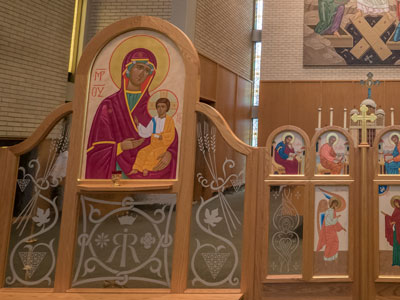
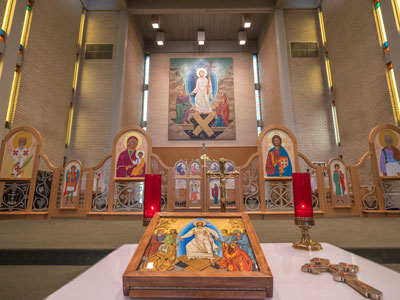
The Mosaics
The mosaics, created by +Boris and Sviatoslav Makarenko were created and installed in 1987 in preparation for the 1988 Millennium celebration.
The icon of Christ the Lover of us all presents Christ blessing us and teaching everyone about salvation and the Mother of Perpetual Help displays her immense and loving participation in humanity’s salvation – the Mother of Christ and the Mother of all God’s children.
The Stations of the Cross were also created to deepen the devotion of the parishioners for the great love portrayed by Jesus who truly loves each and everyone.
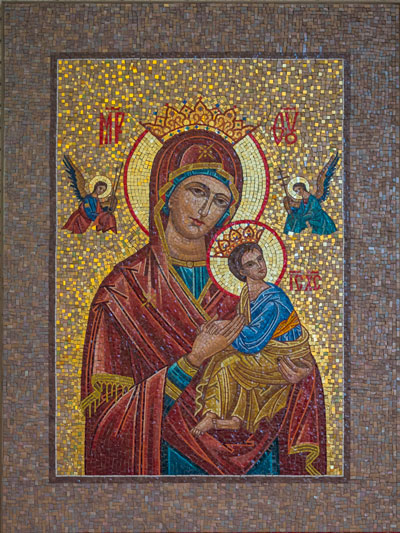
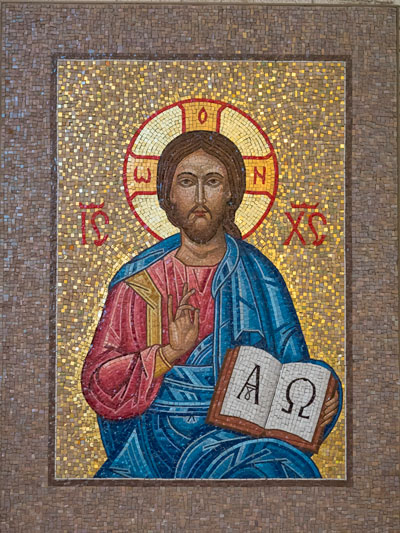
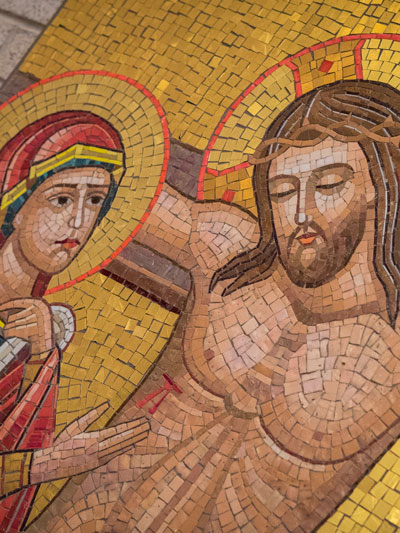
STAINED GLASS ICON OF THE NATIVITY
The immense Byzantine stained glass Icon 21’x19′, created by Makarenko Studios above the entrance, was installed in the autumn of 2010. It faithfully reflects the traditional understanding of the Nativity of Jesus according to eastern iconography. It powerfully portrays the Heavenly Kingdom penetrating the earthly Cosmos pointing to the Star of Bethlehem which, in turn, directs the viewer’s attention to the Infant Jesus, born in a stable amidst the lowly animals.
The child Jesus is wrapped in swaddling clothes, much akin to a burial shroud, reminding all that this Holy Child is also born to die for mankind. Even the cradle reminds everyone of a sepulchre in which Jesus will be placed after His crucifixion. The handmaidens in the lower right corner are washing the child Jesus to make everyone aware of His humanity. The Heavenly Angel in the upper right of the icon, reminds all of His Divinity and that He is worthy of great praise. The Magi are present offering honour and praise to the new-born King. Poor doubting and confused Joseph, who represents all of humanity, is being comforted by the Blessed Mother to trust in God and to believe in the greatness of this child – the Son of God.
With the new church decorations, St. Joseph’s parishioners may now more strongly visualize their faith in Jesus Christ. Through the presence of the Iconostas and the various Icons, they profoundly experience that their salvation is here and now. Worshippers happily stand in God’s holy presence as they prayerfully listen to the Holy Gospel and reverently celebrate the sacred Mysteries of their faith.
In Jesus Christ all are formed into a holy People of God and are called to live a life of Christian witness. Humbly, everyone begins to more fully realize that every person is created in the image and likeness of God and therefore, are most worthy of love. Jesus warmly invites: “Love one another as I have loved you.”
May all Christians grow as living Icons of our Lord Jesus Christ and Saviour. May they walk in the path of the saints and grow in faith, life and spiritual wisdom and understanding.
On this very blessed and happy occasion, Father Bohdan Lukie CSsR, the Pastor of St. Joseph’s expressed heartfelt words of gratitude to all the parishioners who dared to believe that all these beautiful Church Decorations could be accomplished and generously supported this major project, not only with encouraging words, but with strong financial support. All donations will all be acknowledged on the Memorial and Honorary Plaque at the church door.
The parish President Gary Winch also conveyed words of appreciation and gratitude to Metropolitan Lawrence for his encouragement and his blessing.
A most special Thank You was also conveyed to +Boris Makarenko, Sviatoslav and his young artistic family who have devoted much time and energy to the beautification of St. Joseph’s Church with the creation of all the Mosaics, the Stain Glass windows and the Iconostas. God bless them all and Mnohaya i Blahaya Lita!!!
